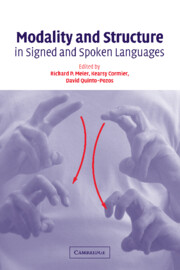Book contents
- Frontmatter
- Contents
- List of figures
- List of tables
- List of contributors
- Acknowledgements
- 1 Why different, why the same? Explaining effects and non-effects of modality upon linguistic structure in sign and speech
- Part I Phonological structure in signed languages
- Part II Gesture and iconicity in sign and speech
- Part III Syntax in sign: Few or no effects of modality
- Part IV Using space and describing space: Pronouns, classifiers, and verb agreement
- 13 Pronominal reference in signed and spoken language: Are grammatical categories modality-dependent?
- 14 Is verb agreement the same crossmodally?
- 15 The effects of modality on spatial language: How signers and speakers talk about space
- 16 The effects of modality on BSL development in an exceptional learner
- 17 Deictic points in the visual–gestural and tactile–gestural modalities
- Index
- References
13 - Pronominal reference in signed and spoken language: Are grammatical categories modality-dependent?
Published online by Cambridge University Press: 22 September 2009
- Frontmatter
- Contents
- List of figures
- List of tables
- List of contributors
- Acknowledgements
- 1 Why different, why the same? Explaining effects and non-effects of modality upon linguistic structure in sign and speech
- Part I Phonological structure in signed languages
- Part II Gesture and iconicity in sign and speech
- Part III Syntax in sign: Few or no effects of modality
- Part IV Using space and describing space: Pronouns, classifiers, and verb agreement
- 13 Pronominal reference in signed and spoken language: Are grammatical categories modality-dependent?
- 14 Is verb agreement the same crossmodally?
- 15 The effects of modality on spatial language: How signers and speakers talk about space
- 16 The effects of modality on BSL development in an exceptional learner
- 17 Deictic points in the visual–gestural and tactile–gestural modalities
- Index
- References
Summary
Introduction
Language in the visual–gestural modality presents a unique opportunity to explore fundamental structures of human language. One of the larger, more complex questions that arises when examining signed languages is the following: how, and to what degree, does the modality of a language affect the structure of that language? In this context, the term “modality” refers to the physical systems underlying the expression of a language; spoken languages are expressed in the aural-oral modality, while signed languages are expressed in the visual–gestural modality.
One apparent difference between signed languages and spoken languages relates to the linguistic expression of reference. Because they are expressed in the visual–gestural modality, signed languages are uniquely equipped to convey spatial–relational and referential relationships in a more overt manner than is possible in spoken languages. Given this apparent difference, it is not unreasonable to ask whether systems of pronominal reference in signed languages are structured according to the same principles as those governing pronominal reference in spoken languages.
Following this line of inquiry, this typological study explores the grammatical distinctions that are encoded in pronominal reference systems across spoken and signed languages. Using data from a variety of languages representing both modalities, two main questions are addressed. First, are the categories encoded within pronoun systems (e.g. person, number, gender, etc.) the same across languages in the two modalities? Second, within these categories, is the range of distinctions marked governed by similar principles?
- Type
- Chapter
- Information
- Modality and Structure in Signed and Spoken Languages , pp. 329 - 369Publisher: Cambridge University PressPrint publication year: 2002
References
- 72
- Cited by



